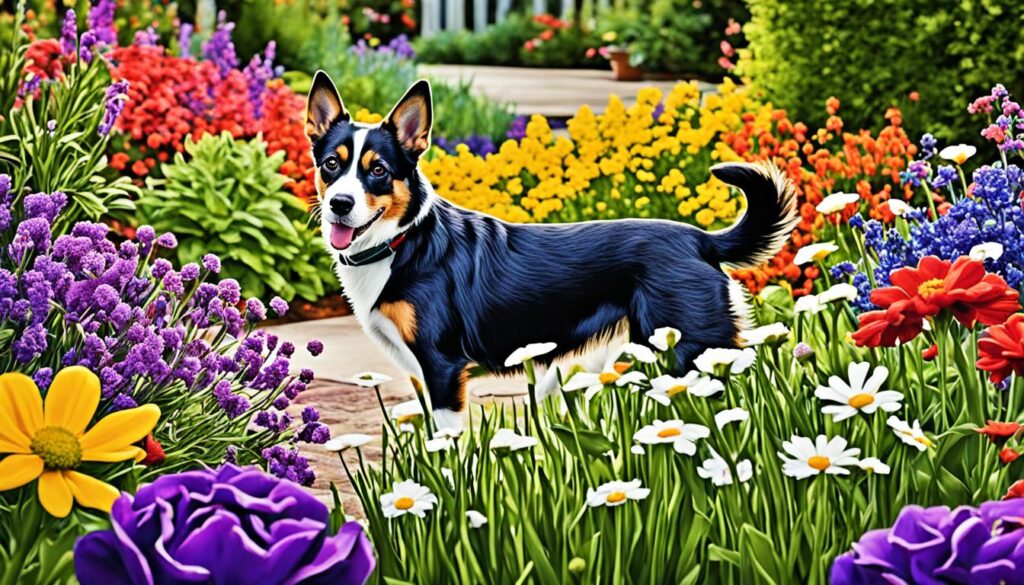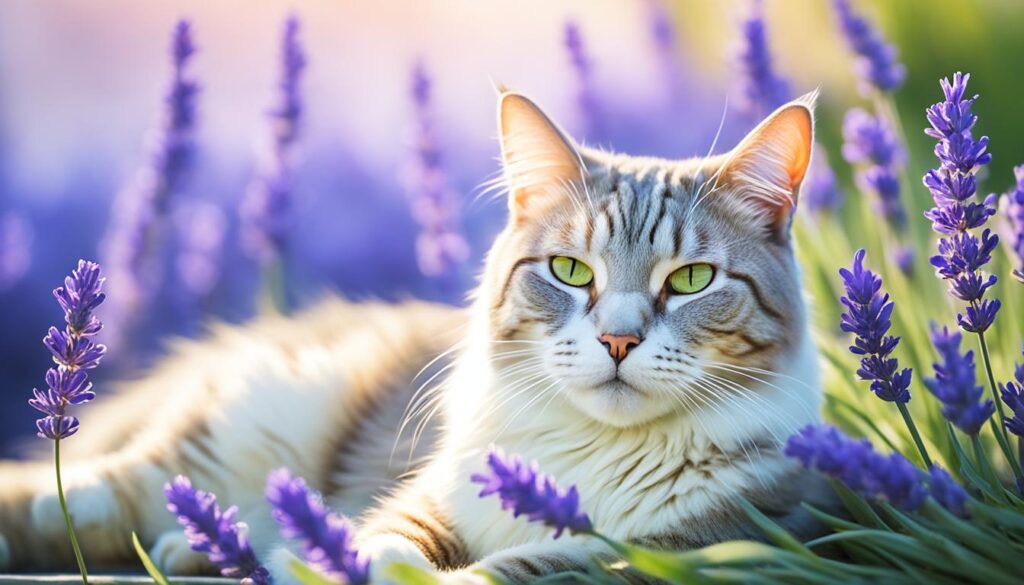What if the colors you pick for your pet’s stuff could really change their mood and actions?
Welcome to a look at color psychology pets that will surprise you. We love our pets so much, but there’s still a lot to learn about how they see the world, especially colors. Dogs and cats see colors differently than we do, thanks to their special animal color vision. This affects how they act and react to their surroundings.
Dogs see the world in black, white, and shades of gray, mainly because they have two types of cones in their eyes. To them, red looks like dark brown or gray. They see red, green, and orange as different shades mixed with blue or gray. vision is simpler, but it doesn’t mean they don’t have deep visual experiences.
Over time, dogs have developed amazing ways to see in low light. They have more rod cells in their eyes, helping them see better in the dark. These skills helped their ancestors survive. Knowing these things can make your bond with your pet even stronger.
Key Takeaways:
- Dogs are dichromatic, seeing mainly blues, yellows, and grays.
- Red looks dark brownish-gray or black to dogs.
- Dogs are great at seeing in low light, which helps their night vision.
- Their evolution has shaped their visual abilities today.
- Understanding dogs’ color perception can improve training and interaction.
- Adding different textures and colors to your dog’s space makes them more curious.
Understanding Pet Color Perception: How Do Dogs and Cats See Colors?
Exploring how pets see colors is really interesting. It shows us how dogs and cats see the world differently from us. Let’s look into their unique ways of seeing colors.
Dog Color Vision: Dichromatic View
Dogs have dichromatic vision. They don’t see colors like humans do because they have only two types of color cones. This means they see colors more like people with red-green color blindness. Dogs are more drawn to blue and yellow, which affects what they like and how they see their world.
| Species | Color Cones | Perception |
|---|---|---|
| Humans | Three | Full spectrum |
| Dogs | Two | Yellow and Blue |
Cat Color Vision: Unique Sensitivities
Cats see the world in a special way, different from dogs. They have fewer color cones than humans, so they don’t see colors as well. Some studies say they might see mainly blue and gray, or even some yellow, like people with red-green color blindness. They also see things less clearly up close.
But, cats are great in low light because they have lots of rod cells in their eyes. This helps them see motion well, even from far away.
Cats’ eyes are made for survival. The tapetum, special cells under the retina, helps them see in the dark. This is why they’re so good at hunting at night.
| Aspect | Dogs | Cats |
|---|---|---|
| Color Cones | Two | Limited |
| Best Perceived Colors | Yellow and Blue | Blue and Gray (possibly Yellow) |
| Low Light Vision | Limited | Excellent (due to Tapetum) |
Comparing Canine and Feline Color Perception
Looking at how dogs and cats see colors shows us how they’ve evolved differently. Dogs are better at seeing blues and yellows, while cats are great in the dark. This is important for their hunting at night.
Knowing these differences helps us design better products for pets. For dogs, using blue and yellow in toys can make them more appealing. For cats, designing products that work well in low light can make them more engaging.
The Science Behind Pet Color Preferences and Reactions
Colors affect our pets’ behavior, mood, and even how they react physically. Knowing this can help make their living spaces better. Dogs and cats see colors differently, which affects how they respond to them.
Behavioral Responses to Different Colors
Pets react to colors based on how they see them and their past experiences. Dogs see blue and yellow well but not red and green. They are great at seeing in low light and spotting motion. This helps them hunt and stay safe.
Dogs also like certain colors when they mean treats. This shows how color can help in training them.
Color Psychology in Pets: Influencing Mood and Behavior
Pets feel the effects of color too. Bright colors like yellow and orange make them more active and happy. On the other hand, colors like blue and green calm them down and reduce stress.
This knowledge helps in choosing the right toys and accessories for pets.
Impact of Color on Pet Anxiety and Relaxation
Colors can make pets feel less anxious and more relaxed. Soft blues and greens are great for calming anxious pets. Cats and dogs become calmer when surrounded by these colors.
Using these colors in pet accessories or decor can help reduce pet anxiety.
The Role of Color in Pet Accessories: How Pets Perceive and React
Pet owners and manufacturers need to know how color affects pet accessories. Dogs see mainly blues and yellows because they have dichromatic vision. This means using these colors in pet accessories can make pets more interested and interactive. Cats see gray, blue, and yellow, so picking the right colors can attract their attention too.
Choosing the Best Colors for Pet Toys and Accessories
When picking colors for pet accessories, think about how pets see them. Dogs are drawn to blue and yellow because they can see these colors well. A bright blue chew toy will likely catch a dog’s eye and keep them busy. Cats like gray, blue, and yellow too, so use these in cat products.
Colors to Avoid in Pet Products
Some colors don’t work well in pet accessories if you want pets to engage with them. Red, green, and orange are hard for dogs to see because of their vision. These colors might make pets less interested in toys or products. Dark colors can also turn pets off, so use them sparingly in pet accessories.
Pet Color Preferences by Breed
Some pets prefer certain colors based on their breed and how they see the world. All dogs like blue and yellow, but some breeds might have a special fondness for certain colors. For example, hunting breeds might like colors that match their natural environment. Making pet accessories that match these preferences can make them more appealing to different breeds.
| Species | Color Perception | Preferred Colors | Colors to Avoid |
|---|---|---|---|
| Dogs | Blues, Yellows | Blue, Yellow | Red, Green, Orange |
| Cats | Gray, Blue, Yellow | Gray, Blue, Yellow | Red, Green |
Knowing the best colors for pet accessories helps manufacturers and pet owners create products that pets love. Using the right colors makes accessories safe, fun, and engaging. Avoiding colors pets can’t see well ensures they stay interested and happy with their toys and accessories.
Utilizing Color Therapy for Pets: Enhancing Well-being
Pet owners are now using *pet color therapy* to help their pets stay healthy and happy. This section will explore how color therapy works for pets. It will cover its benefits and how to add color therapy to pet spaces.
What is Color Therapy and How It Works for Pets?
Color therapy, also known as chromotherapy, uses colors to improve health and mood. Pets can greatly benefit from certain colors. For example, blue can calm pets, green can reduce stress, and purple can help them relax.
Benefits of Color Therapy in Pet Environments
Color therapy has many benefits for pets. Using colors in a pet’s space can make them more relaxed, less anxious, and even help them heal. Here are some benefits:
- Enhanced Relaxation and Calmness: Colors like blue, green, and purple make pets feel calm and less anxious.
- Boosted Energy Levels: Colors such as yellow, orange, and red can make pets more energetic and lively.
- Physical Healing: Colors like pink and turquoise can help pets recover from illness or injury.
Practical Tips to Incorporate Color Therapy
Adding color therapy to a pet’s life is easy. Here are some tips:
- Home Décor: Paint walls in calming colors and use curtains and bedding in soothing tones.
- Lighting: Use color-changing LEDs or filters on lights to create a calming atmosphere.
- Accessories and Apparel: Dress pets in colors like blue or green with sweaters or bandanas.
- Aromatherapy: Use scents with color therapy for a better effect on well-being.
Using *pet color therapy* helps owners care for their pets in a holistic way. It makes sure pets live in spaces that are caring and healing. Keeping up with *pet color trends for 2024* keeps these methods up-to-date and effective for pets.
Conclusion
Our journey into how color affects pets has shown us a lot. We learned how different colors impact their vision, actions, and happiness. Dogs see colors differently because they have special vision. Cats also have unique ways of seeing the world.
Choosing the right colors for pet accessories and spaces can make a big difference. Colors like black and white or yellow against dark backgrounds catch a dog’s eye. Colors like blue can calm a pet, while yellow can make them more energetic.
Understanding pet color perception helps in marketing and selling pet products. Pet owners and businesses can make better choices for their pets’ well-being and satisfaction. Using colors in a way that helps pets can reduce their stress, increase their energy, and help them heal.
These insights are changing how we care for pets. By using what we know about pet color perception, we can make spaces that help pets relax and feel emotionally balanced. This approach strengthens the bond between pets and their owners. It shows our dedication to their happiness and health.


